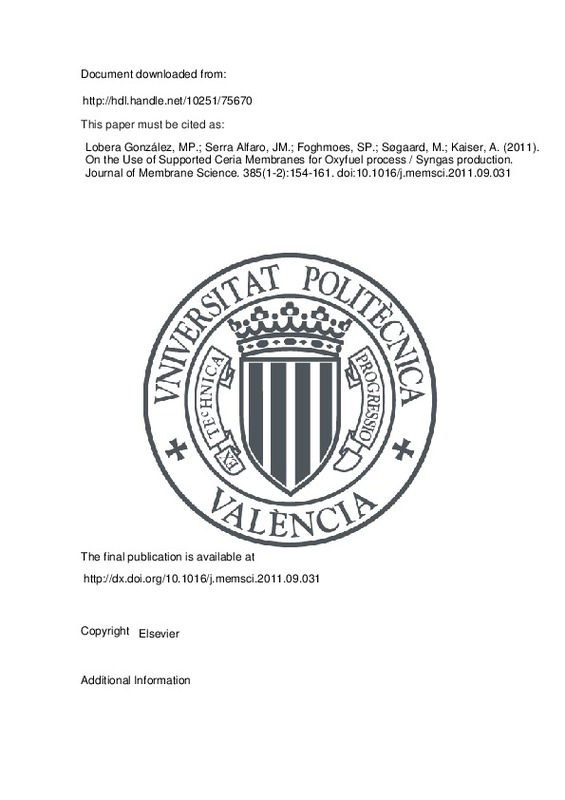JavaScript is disabled for your browser. Some features of this site may not work without it.
Buscar en RiuNet
Listar
Mi cuenta
Estadísticas
Ayuda RiuNet
Admin. UPV
On the Use of Supported Ceria Membranes for Oxyfuel process / Syngas production
Mostrar el registro sencillo del ítem
Ficheros en el ítem
| dc.contributor.author | Lobera González, Maria Pilar
|
es_ES |
| dc.contributor.author | Serra Alfaro, José Manuel
|
es_ES |
| dc.contributor.author | Foghmoes, Soren P.
|
es_ES |
| dc.contributor.author | Søgaard, Martin
|
es_ES |
| dc.contributor.author | Kaiser, Andreas
|
es_ES |
| dc.date.accessioned | 2016-12-22T12:19:09Z | |
| dc.date.available | 2016-12-22T12:19:09Z | |
| dc.date.issued | 2011-12-01 | |
| dc.identifier.issn | 0376-7388 | |
| dc.identifier.uri | http://hdl.handle.net/10251/75670 | |
| dc.description.abstract | [EN] Ceramic oxygen transport membranes (OTMs) enable selective oxygen separation from air at high temperatures. Among several potential applications for OTMs, the use in (1) oxygen production for oxyfuel power plants and (2) the integration in high-temperature catalytic membrane reactors for alkane upgrading through selective oxidative reactions are of special interest. Nevertheless, these applications involve the direct contact of the membrane surface with carbon-rich atmospheres. Most state-of-the-art permeable membranes are based on perovskites, which are prone to carbonation under operation in CO2-rich environments and/or decomposition in reducing gas environments. The oxygen flux through supported thin film membranes of Ce-0.9Gd0.1O1.95-delta (CGO) with 2 mol.% of cobalt was measured for oxygen separation in oxyfuel processes and in syngas production and degradation was compared to perovskite membranes. The CGO membranes consist of a 27 mu m-thick gastight CGO layer supported on a porous CGO substrate. The flat surface of the membrane was coated using two different porous catalytic layers aiming to improve the oxygen activation rate on the permeate side while the porous substrate was infiltrated with an oxygen reduction catalyst. Oxygen separation was studied using air as feed and argon/CO2 or argon/CH4 mixtures as sweep gas in the temperature range 750-1000 degrees C. The supported membrane exhibited a maximum oxygen flux of ca. 5 ml min(-1) cm(-2) at 1000 degrees C when diluted methane was used as sweep gas. The CGO membrane showed high stability in CO2 (in contrast to tests on La0.6Sr0.4Co0.2Fe0.8O3-delta (LSCF) membranes) and no detrimental effect on the oxygen flux is observed when CO2 is present in the sweep gas even at temperatures below 800 degrees C. Moreover, the SEM analysis showed that membrane integrity remained stable after the permeation tests using CO2. (C) 2011 Elsevier B. V. All rights reserved. | es_ES |
| dc.description.sponsorship | Financial support by the Spanish Ministry for Science and Innovation (Project ENE2008-06302) and by the EU through FP7 NASA-OTM Project (NMP3-SL-2009-228701) is kindly acknowledged. | en_EN |
| dc.language | Inglés | es_ES |
| dc.publisher | Elsevier | es_ES |
| dc.relation.ispartof | Journal of Membrane Science | es_ES |
| dc.rights | Reconocimiento - No comercial - Sin obra derivada (by-nc-nd) | es_ES |
| dc.subject | Cerium gadolinium oxide | es_ES |
| dc.subject | Supported membrane | es_ES |
| dc.subject | Tape casting | es_ES |
| dc.subject | MIEC | es_ES |
| dc.subject | Syngas | es_ES |
| dc.subject | Oxyfue | es_ES |
| dc.title | On the Use of Supported Ceria Membranes for Oxyfuel process / Syngas production | es_ES |
| dc.type | Artículo | es_ES |
| dc.identifier.doi | 10.1016/j.memsci.2011.09.031 | |
| dc.relation.projectID | info:eu-repo/grantAgreement/MICINN//ENE2008-06302/ES/BUSQUEDA DE NUEVOS MATERIALES CONDUCTORES DE OXIGENO E HIDROGENO EN ESTADO SOLIDO MEDIANTE QUIMICA COMBINATORIA/ | es_ES |
| dc.relation.projectID | info:eu-repo/grantAgreement/EC/FP7/228701/EU/NAnostructured Surface Activated ultra-thin Oxygen Transport Membrane/ | es_ES |
| dc.rights.accessRights | Abierto | es_ES |
| dc.contributor.affiliation | Universitat Politècnica de València. Instituto Universitario Mixto de Tecnología Química - Institut Universitari Mixt de Tecnologia Química | es_ES |
| dc.description.bibliographicCitation | Lobera González, MP.; Serra Alfaro, JM.; Foghmoes, SP.; Søgaard, M.; Kaiser, A. (2011). On the Use of Supported Ceria Membranes for Oxyfuel process / Syngas production. Journal of Membrane Science. 385(1-2):154-161. https://doi.org/10.1016/j.memsci.2011.09.031 | es_ES |
| dc.description.accrualMethod | S | es_ES |
| dc.relation.publisherversion | http://dx.doi.org/10.1016/j.memsci.2011.09.031 | es_ES |
| dc.description.upvformatpinicio | 154 | es_ES |
| dc.description.upvformatpfin | 161 | es_ES |
| dc.type.version | info:eu-repo/semantics/publishedVersion | es_ES |
| dc.description.volume | 385 | es_ES |
| dc.description.issue | 1-2 | es_ES |
| dc.relation.senia | 207568 | es_ES |
| dc.contributor.funder | European Commission | |
| dc.contributor.funder | Ministerio de Ciencia e Innovación |







![[Cerrado]](/themes/UPV/images/candado.png)

